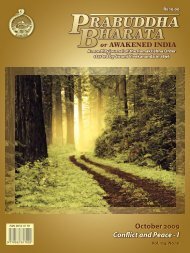According
August 2009 - Advaita Ashrama
August 2009 - Advaita Ashrama
- No tags were found...
You also want an ePaper? Increase the reach of your titles
YUMPU automatically turns print PDFs into web optimized ePapers that Google loves.
PB August 2009<br />
Spiritual Substance and Perfection in Indian Thought 41<br />
Equally remarkable is the concept of liberation<br />
in Vedanta. In Vedanta, moksha is not a negative<br />
concept, but a positive state. It is true that liberation<br />
from samsara is the end of all earthly pain,<br />
but the end coincides with the emergence of unobstructed<br />
bliss. This bliss is different from earthly<br />
happiness. It is a transcendental bliss beyond all<br />
difference and duality. Worldly happiness is fraught<br />
with such dualities as pleasure and pain, but pure<br />
transcendental bliss is unalloyed.<br />
More important, this condition of bliss can be<br />
achieved by the aspirant here and now, while still<br />
living in this world. When the realization that this<br />
world is maya—and therefore mithyā, devoid of<br />
an ultimate meaning—and that Brahman alone<br />
is real is fully integrated with one’s practical conduct,<br />
then the person achieves liberation here and<br />
now. This is jīvanmukti, freedom while living. A<br />
jīvanmukta continues to live till the momentum of<br />
his past actions remains in operation, performing<br />
actions without any sense of obligation, dedicating<br />
one’s actions and their fruits either to God or to<br />
the welfare of society. Being selfless, the jīvanmukta<br />
has no desires to be fulfilled. The process of liberation<br />
culminates in the death of the body, and the<br />
liberated soul does not come back to this world in<br />
any bodily form, as the association of the self with<br />
the body and mind is permanently severed. This is<br />
videhamukti.<br />
This brief account underscores the importance<br />
accorded to the conception of spiritual substance<br />
and liberation in each of the orthodox Indian<br />
philosophical systems. Even though some of these<br />
systems may not have been able to elucidate a<br />
very satisfactory view of the self and its liberation,<br />
due to difficulties inherent in their basic tenets,<br />
they have nevertheless grappled hard with these<br />
formulations.<br />
Of the heterodox systems, it is perhaps the<br />
Charvakas—the school of materialists—alone,<br />
that neither accepts Vedic authority nor the reality<br />
of God, of the self as an entity separate from the<br />
body, or of liberation. It accords reality only to<br />
matter. Also, it believes that our present life is the<br />
only life we have. There is no hereafter, and death<br />
involves total annihilation of the human personality.<br />
The other heterodox schools—that of Jainism<br />
and Buddhism—also do not accept the concept of<br />
God or the authority of the Vedas. But they view<br />
the yogic path of spiritual discipline as one that<br />
leads to liberation.<br />
P<br />
(Continued from page 460)<br />
Again, it cannot be said that, inasmuch as it<br />
has parts, consciousness is a compound and must<br />
share the fate of all compound entities: destruction.<br />
That holds good in the case of material things only.<br />
It cannot be predicated of consciousness. Do we<br />
not see every moment of our lives that the many<br />
thoughts, feelings, and urges bobbing up and down<br />
in our mind are nothing but consciousness? But<br />
do any of them die, or get destroyed? They abide<br />
even when all discrete material things vanish into<br />
their source—the so-called ultimate homogeneous<br />
force or energy. We have used the word ‘part’ in<br />
the context of consciousness, but the connotation<br />
is not the same as in relation to a material thing.<br />
Matter can be cut or torn, not so consciousness.<br />
Leaving aside the basic consciousness, the active or<br />
willing-consciousness remains the same unruffled<br />
unmoving consciousness, in spite of its innumerable<br />
modes and manners; it neither increases nor<br />
decreases, and yet produces a bewildering multitude<br />
of ideas and emotions, all the while retaining<br />
its command over them—even as the earth remains<br />
but earth though the shapes and sizes of earthenware<br />
appear, change, and vanish.<br />
To kill or destroy requires two. Consciousness<br />
is singular, infinite in all respects, within and<br />
beyond time and space. Who can destroy it or<br />
make it change in a manner other than its own?<br />
Abiding peace is attained only when this thoroughly<br />
reasoned posture of the identity of ‘feelingconsciousness’<br />
and ‘willing-consciousness’ has<br />
become a permanent experience in life under all<br />
circumstances. And this is the goal of life as well as<br />
the paramarthika satya, ultimate Truth. P<br />
481
















